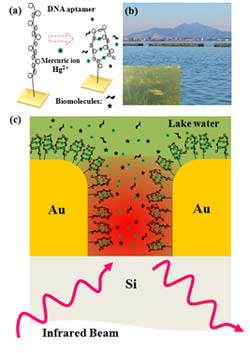Development of High Sensitivity Detection Method for Diluted Ionic Mercury in Water

Figure: (a) Schematic of the surface coating material (DNA aptamer). Only the ionic mercury is selectively adsorbed; organic molecules are not trapped. (b) Lake Kasumigaura, where the natural water was sampled. (c) Schematic of a nanogap on the gold surface, which was coated with the surface coating material.<br>
A research group of WPI-MANA, including Dr. Chung Vu Hoang (Doctoral Research Fellow) at MANA (International Center for Materials Nanoarchitectonics), NIMS (National Institute for Materials Science, President: Sukekatsu Ushioda), Dr. Tadaaki Nagao, Group Leader of the NIMS Nano-System Photonics Group, Dr. Masakazu Aono, Director-General of MANA, and others discovered that it is possible to detect of ionic mercury, with more than 10 times higher sensitivity than with the conventional spectroscopy method.
Ionic mercury is a harmful substance when dissolved in rivers, lakes, marshes, etc. in even trace amounts. In contrast to the conventional spectroscopic detection method, the infrared spectroscopy detection method was used in detection.
Mercury is a serious environmental pollutant which is hard to control and decontaminate. Its sources range from small scale gold mines, metal refining plants, to combustion of fossil fuels, volcanic activity, and crematoriums. In everyday products, it is emitted from dry cell batteries, fluorescent tubes, thermometers, blood pressure gauges, and so on. As mercury is easily vaporized at room temperature and diffuses rapidly in the atmosphere, it is a ubiquitous pollutant on a global scale.
On January 19, 2013, the United Nations ratified a new Convention on Mercury Control, following multinational negotiations that began on January 13. Because mercury contamination generally accumulates in living organisms and gradually progresses over time, early detection of low concentrations of mercury in environmental water is an important issue.
In this research, the NIMS group developed a method of detecting ionic mercury from water selectively and with high sensitivity by fabricating a gold nanogap structure coated with molecules which shows strong specific adsorption of ionic mercury. Although infrared spectroscopy had been believed to be unsuitable for the measurement of trace amounts of analytes in water, the unnecessary spectrum of water was reduced by using plasmons formed in the nanogaps of the gold, making it possible to apply this method. The NIMS researchers also found that the detection limit of ionic mercury with a standard Fourier transform infrared (FT-IR) spectrometer can be decreased to the ppt (part per trillion) level as a result of the improved sensitivity obtained by plasmon field enhancement in the nanogaps.
Ionic mercury dissolved in water cannot be measured as-is by infrared spectroscopy. However, by selective adsorption by the surface coating material in this work, it was possible to selectively detect ionic mercury and other components when mercury was intentionally dissolved at a concentration on the order of 30ppt in natural water from Lake Kasumigaura. From this research, it was found that mercury contamination of lakes and rivers can be assessed from trace levels using infrared spectroscopy. In the future, this detection method is expected to be developed into simple, precise monitoring techniques. Such techniques are expected for contributing to the detection of other types of environmental pollutions as well as to the industrial waste water treatment.
These research results will be published in the online bulletin of Scientific Reports on February 6, 2013 (Japan time).
Media Contact
All latest news from the category: Materials Sciences
Materials management deals with the research, development, manufacturing and processing of raw and industrial materials. Key aspects here are biological and medical issues, which play an increasingly important role in this field.
innovations-report offers in-depth articles related to the development and application of materials and the structure and properties of new materials.
Newest articles

Silicon Carbide Innovation Alliance to drive industrial-scale semiconductor work
Known for its ability to withstand extreme environments and high voltages, silicon carbide (SiC) is a semiconducting material made up of silicon and carbon atoms arranged into crystals that is…

New SPECT/CT technique shows impressive biomarker identification
…offers increased access for prostate cancer patients. A novel SPECT/CT acquisition method can accurately detect radiopharmaceutical biodistribution in a convenient manner for prostate cancer patients, opening the door for more…

How 3D printers can give robots a soft touch
Soft skin coverings and touch sensors have emerged as a promising feature for robots that are both safer and more intuitive for human interaction, but they are expensive and difficult…





















